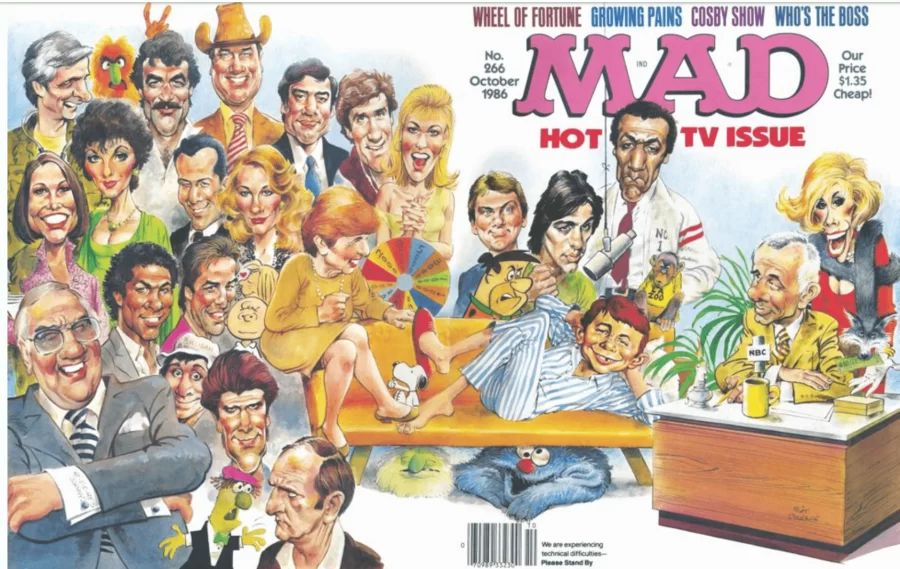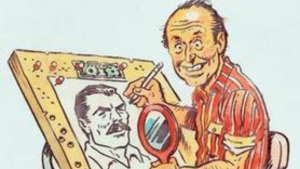Everything I learned about Jewish humor I learned from Mad magazine
For a Catholic kid from a white-bread town, the usual gang of idiots offered an education and a lifeline.
Published June 14, 2022
I grew up in central Maine in the ’60s and ’70s, and while we weren’t exactly the Mayberry of the North — the fictional town of “The Andy Griffith Show” — if you were looking to find a nearly 100% all-white Catholic and Protestant enclave above the Mason-Dixon Line, we were it.
Not that we were a hick town. We lived in Orono — where the University of Maine was and is — and our nearest big city was Bangor. I liked to consider us quasi-cosmopolitan, the last outpost of civilization in the state before you went deep into the woods and met people saying “ay-uh.”
But integration? Well, a Black girl joined our high school my junior year, the daughter of a doctor who for whatever reason decided to move there. That meant just as Mayberry had exactly one Black actor with a speaking role — Rockne Tarkington as Flip Conroy — we had one Black student.
We had, to the best of my knowledge, one Jewish student. Her name was Melaine Gershman, the daughter of Mel and Elaine, hence the portmanteau Melaine. Every year around Christmas the poor girl had to explain Hanukkah to the once-interested, long-bored class.
The only other Jews I interacted with were my dentist, Dr. Howard Kominsky, who did good work on my teeth and gave me his old weathered leather golf bag when he was done with it, and Mickey Goldsmith, who founded Goldsmith’s Sporting Goods, where I bought my baseball gloves and bats.
ADVERTISEMENT
Nevertheless, there was a profound Jewish influence on my outlook on life, specifically my sense of humor. I just didn’t know it at the time.
I fell in love with language and wordplay at a young age. I grasped the concept of irony and satire early on. I didn’t like authority and a fifth-grade teacher once scolded me for giving her some back talk. She said there was a difference between being famous and notorious and I was destined for the latter. She had a big vocabulary and that was pretty advanced thinking. I was OK with it.
I chalk a lot of my attitude up to Mad magazine. I began reading Mad around 1967 when I was 11, and in short order I became a subscriber. I didn’t get a lot of mail — Baseball Digest was my other mag — and when Mad came every month (or so), I tore open the white envelope, flopped down on my bed and read it cover to cover, always ending with Al Jaffee’s Fold-In. I was a voracious reader, eager to discover what smart yuks the self-proclaimed “usual gang of idiots” at Mad had in store for me.
I didn’t know that most of the writers, cartoonists and editors were Jewish, nor would I have likely cared one way or the other. All I knew about Judaism was from my Catholic upbringing, which was that we should respect the Jews, but, sadly, they couldn’t enter the kingdom of heaven because, you know, Jesus.
Even as a kid and one-time altar boy, this struck me as both uncharitable and absurd, and I’m sure was one of the building blocks on my way toward being an agnostic recovering Catholic. (If you want to go deeper, you could add transubstantiation, virgin birth and resurrection, all of which came clanging into my consciousness upon reaching, as I like to call it, “the age of reason.”)
At any rate, funny was funny, no matter where it came from. (I was also a future fan of a Richard Pryor album whose title I’m pretty certain I can’t repeat here in 2022.) When I learned about the Jewish factor in my comedic education, it tickled me. And made sense. It had become one of my primary prisms through which to filter the world.
But I didn’t just learn about the modern world from the new Mads. I learned about what life — in the Mad world at least — had been like before I was sentient. Much the same, but with unfamiliar reference points — politicians I’d barely heard of, movies and TV shows before my time, parodic lyrics of songs I didn’t know.
My family lived on the first floor of what had once been a large dance hall in the 1930s, later converted into three apartments. The people that owned the building and lived upstairs were my parents’ best friends, and they had two sons, a generation-and-a-half up from me. They were avid Mad readers who never threw the mags away. As they had left home, I was fortunate enough to have been bequeathed a trunkful of their old Mads from the ’50s and early ’60s. (I still have them. They’re a tad musty.)
That being the case, Yiddish knockoff words had long entered my world, words like furshlugginer, which I later learned was derived from the Yiddish word shlogan (to hit) and a few more that I was shocked to see were, uh, dirty. And to these gentile ears, shmuck, shnook and shlemiel sounded pretty funny.
Another Catholic-raised, Mad-inspired kid was Boston comic Mike McDonald. “We’re talking about the ’60s, and there were limited humor magazines, certainly limited for 12-year-old boys,” he told me. “Mad was trying to appeal to that group and it did. You didn’t have a lot of money to spend at 11 or 12 so if you’re gonna lay money out for something, this was it.”
And then came the stand-ups. “Even as a kid watching comedians,” McDonald said, “I realized being Jewish meant you had a sense of humor, and half of the best comics were Jewish — Shelley Berman, Mort Sahl, Joan Rivers, Jackie Mason. They didn’t talk about being Jewish much in their acts, but it was apparent to me that part of being Jewish was to be able to laugh at yourself and be funny. You can’t say that about all other cultures.”
Leah Garrett, director of the Jewish Studies Center at Hunter College and a Forward contributor, read Mad, too: “For an entire generation, Mad magazine was one of the most central factors in shaping how we understood the adult world and what it meant,” she said. “The magazine would end up employing and inspiring basically every important American comic, particularly all the Jewish comics — Sid Caesar, Mel Brooks, Jerry Seinfeld, Howard Stern, the writers of ‘The Simpsons,’ the writers of ‘Saturday Night Live,’ The Onion, ‘The Daily Show’ — just to name a few. I would say it was the most important comedy vehicle in American history.”
I learned a lot about advertising from these guys (Mad had no advertising), about guileful manipulation, about how corporate interests weren’t exactly aligned with ours. As was often the same with government and governmental bureaucracy. I learned about irreverence, and that there were no sacred cows. About humor as both an offensive jab or a perfectly acceptable defensive position. That laughing at the ludicrous (or even heinous) things all around us was not a bad response. Often, that laughter led to a deeper understanding of issues.
All of these views were overseen by Mad’s gap-toothed, ever-jovial (but what did he know?) mascot, Alfred E. Neumann, with his “What, me worry?” point of view. And Mad’s motto: “Humor in the jugular vein.”
David Bieber was a Jewish kid from Cleveland who was hooked from the get-go. A former promotions director at Boston rock radio station WBCN and alternative paper The Boston Phoenix, Bieber is a pop culture collector and the curator of the David Bieber Archives in Norwood, Massachusetts.
“Mad hit me at that exact right moment,” Bieber said. He was 11 when he began the Mad journey. “Earlier I wouldn’t have appreciated it because I was too much a child. Everyone had their five-to-eight-year cycle of Mad with the regular features upgraded to reflect changing times.”
“Mad was all about challenging you to find out about things you didn’t know about,” he said. “It lured you in with clever and funny parodies of Broadway — things we didn’t even see — and yet the storyline and song lyrics played in your head. They force-fed you knowledge in the process of making fun of adult aspects of life. It was beautiful how textured it was. If you didn’t know the joke, you did investigation.”
“For me, there was a comfort zone knowing who these people are,” Bieber added. “Like they were these smart-aleck adolescents making fun of adults. There was this comedic summit they reached and held on to.”
At the top of that summit was publisher William Gaines. Circling that summit were writers and illustrators like Jaffee, Jack Davis, Harvey Kurtzman, Dave Berg, Norman Mingo, Drew Friedman, Don Martin, Mort Drucker and Sergio Aragonés.
If, in my world of baseball fandom, the Red Sox of 1967 were my Boys of Summer, in my comedic world, these guys were that, too.

















